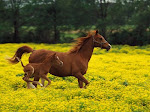There's no doubt long reining has an important role in training - it is after all, where the horse first really learns about communication with the rider through the reins. Because communication with your horse's head and mouth is going to be a fundamental part of its future as a riding horse, it's important to get this early stage right. So where do you start?
First of all, your horse needs to be ready to long rein. You should have established the basics of lunging safely, and your horse should have a willingness to go forward and stop with voice commands on the lunge and while leading. It may seem obvious, but of your horse won't lead - let alone lunge - you aren't ready to long rein!
You will need some equipment to long rein safely. A bridle with the regular reins removed, or for horses not yet bitted, working in a halter with rings at either side of the nose is fine. You will need a surcingle with rings at the side for the long reins, and it is advisable to secure it with a breastgirth to prevent it slipping back or twisting from side to side.
Advanced horses can long rein using surcingle rings at the withers, but for novice horses (and novice long reiners!), rings at the side are best. As with lunging or other work, you might also want to protect your horse's legs with brushing boots or wraps.
If you expect your horse to be a bit reluctant or lazy, a long (such as a carriage driving) whip may be helpful, although you should never strike your horse while long reining. And, of course, you need the long reins, although two lunge lines will do.
Fit the halter or bridle and surcingle, making sure that the girth is secure. If you are using a bridle, fit a halter over it and start with the halter before working with the bit rings. You should introduce your horse to the long reins gradually, and where it can still see you. Begin by lunging your horse normally in both directions until it is relaxed.
Then attach one long rein to the inside halter ring. The other long rein attaches to the outer halter ring, passes through the surcingle loop on that side, and over the horse's back. Hold both reins, one in each hand, and move back from your horse. Begin to encourage it to move forward, with you slightly behind its shoulder, until it is walking comfortably around the circle.




No comments:
Post a Comment